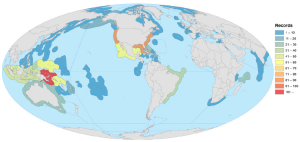A case for the importance and management of fish spawning aggregations
By Rachel Skubel, SRC Intern
Every year, at least 300 species of fish will go to a specific spot in the ocean, at a specific time, for a key event in the continuation of their species: spawning, or releasing eggs to be fertilized. Erisman et al. (2015) detail why these fish spawning aggregations (FSAs) are hotspots of productivity, and why they are intuitive areas to protect.
Over time, fish species come to regularly spawn at these locations in order to maximize fitness (i.e. the survival of their offspring, and thus the propagation of their genes). FSA sites are defined by geomorphology and oceanography that yield high productivity (i.e. upwelling around seamounts that bring nutrients and high primary production), allowing the eventual larvae to feed and increase chances in the larger ocean arena. Not only do spawning fish and their offspring benefit, but the influx of eggs (‘egg boon’) creates a nutrient-dense food source for other animals – this is an example of a ‘trophic cascade’ that can support the health of an ecosystem. Further, marine animals on a migratory route (such as whale sharks) can feed from the resulting feast – which means FSAs are important links between ecosystems. Typically timed with seasons and lunar cycles, many species (up to tens of species) will come to spawn at one FSA site.
Clearly, protecting FSAs is an effective conservation strategy – the benefits go far beyond the spawning species in question, and authorities receive a very high ‘bang for their buck’ so to speak. Protecting one area can replenish numerous species across their ranges. And yet, focused management strategies are lacking.
How do humans fit in the picture?
What with their being so predictably productive over a small area, there are many fisheries associated with FSAs – from commercial to recreational and subsistence. This illustrates the importance of proper management, as overexploiting a species in such a small space, during an important life history event, can impact the fish over a huge spatial and temporal range. The Nassau grouper (Epinephelus striatus) is an excellent example. Formerly a productive and important fishery species in the Caribbean, prolonged overfishing resulted in FSAs being extinguished across its territory. Now, it is listed as endangered by the International Union for the Conservation of Nature.
How are FSAs protected?
Less than 35% of known FSAs receive any amount of protection from marine protected areas. An estimated 52% of FSAs remain unassessed, and of the 906 documented sites (see Russell et al. 2014; Figure 1), most are at reefs and in tropical waters – meaning cold-water aggregations are ripe for discovery and protection. The congregation of so many individuals at a predictable time at one location means that FSAs are valuable for recurring stock assessment. The IUCN World Conservation Congress (circa 2014) recommended governments create management measures that would sustainably protect reef fish and their spawning aggregations, as well as directing NGOs and fishing management organizations to take up the issue. Due to their recurring nature, protection of FSAs is effective for many of the same reasons fishing them is – managers know just which times and places would be most effective for a fishery closure, and this closure is predictable for the resource users as well.

The global distribution of known fish spawning aggregations (Erisman et al. 2015, based on data from Science and Conservation of Fish Spawning Aggregations Global Fish Spawning Database scfra.org/database)
In Europe, the European Union’s Common Fishery Policy now directs the retention of a stocks’ full reproductive capacity to achieve ‘Good Environmental Status’, yet the UK’s Marine Management Organization may implement a spatial zoning approach that prioritizes fishing activity over other uses of a given area. In the US, the Magnusson-Stevens Act (MSA) recognizes FSAs as essential fish habitat (EFH), which fishery management bodies are mandated to minimize fishing impacts upon.
Continuing with the Nassau Grouper example, the Bahamian Government has implemented an annual closed season for the species from December 1st to February 28th to protect their spawning aggregations, which means that ‘taking, landing, possessing, selling, and offering for sale’ is prohibited, and can result in a fine of $5000 or a one-year imprisonment (http://www.thebahamasweekly.com/publish/bis-news-updates/Closure_of_Nassau_Grouper_Fishing_Throughout_The_Bahamas38666.shtml). Dr. Kristine Stump of the Shedd Aquarium is currently studying these ecologically and economically important fish during their breeding seasonin the Bahamas, combining acoustic telemetry, genetic analysis, and blood sampling (http://www.huffingtonpost.com/kristine-stump/nassau-grouper-a-beautiful-fish-at-risk_b_8227446.html).
Going forward, the best chance for successful protection of FSAs may lie in community participation to ensure compliance by fishers. The Coastal Conservation Association in the US is composed of recreational fishers, who were in support of seasonal closures for the Warsaw grouper and speckled hind, realizing that this would allow them to fish the species at other times of the year, for years to come. Effective design is also important; in the Caribbean, the Caribbean Fishery Management Council and South Atlantic Fisheries Management Council aim to establish networks of reserves to protect reef species. Erisman et al. have made an excellent case for the protection of FSAs, and their potential to serve as a success story across conservation and fisheries sectors.
Works cited
Erisman, B., Heyman, W., Kobara, S., Ezer, T., Pittman, S., Aburto‐Oropeza, O., & Nemeth, R. S. (2015). Fish spawning aggregations: where well‐placed management actions can yield big benefits for fisheries and conservation. Fish and Fisheries. doi: 10.1111/faf.12132
Russell, M.W., deSadovy Mitcheson, Y., Erisman, B.E., Hamilton, R.J., Luckhurst, B.E. & Nemeth, R.S. (2014) Status Report – World’s Fish Aggregations 2014. Science and Conservation of Fish Aggregations, California USA. International Coral Reef Initiative.
